Posted June 14, 2023 by Nicky in Reviews / 1 Comment
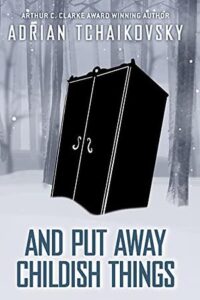 And Put Away Childish Things, Adrian Tchaikovsky
And Put Away Childish Things, Adrian Tchaikovsky
Received to review via Netgalley
In the end, And Put Away Childish Things didn’t really work for me. In part, probably because I’m not actually that cynical and I still like the idea of Narnia and don’t want to think about a Narnia-like world getting all gross and run down. And sure, the main character isn’t actually meant to be likeable, as far as I can tell, but all the same, I don’t like him and I don’t like reading about him.
As a result, I was only mildly engaged with the story, and thus it never came together for me at all. I think there are some neat ideas — Tchaikovsky usually has those! It’s just all a bit grim, and the unpleasant main character never appreciably wises up, and the most interesting characters are all kind of on the side.
Not for me, though I’m confident others will love it.
Rating: 2/5
Tags: Adrian Tchaikovsky, book reviews, books, SF/F
Posted June 10, 2023 by Nicky in Reviews / 0 Comments
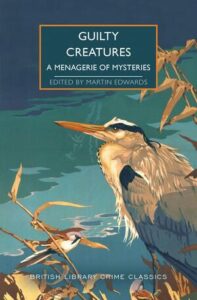 Guilty Creatures, ed. Martin Edwards
Guilty Creatures, ed. Martin Edwards
Guilty Creatures has an interesting idea for a theme (crime/mystery stories centred around animals in some way, usually where animals are the culprits), and is an entertaining read in the aggregate, but I can’t say that any single story actually really stood out to me, except perhaps the one where a tuberculosis infection was a significant clue, given my interests! In some cases the theme was a little bit stretched, to say the least (I won’t say which, since it kind of spoils the point of the story to understand what happened).
The quality of the stories is variable, as so often in short story collections of any kind, but it overall manages to be a fun experience — in part because of the little windows into the author that Edwards gives at the start of each story, providing a little bit of context. It’s very easy reading, as well: if you don’t like one story or style, the next is coming up very soon.
Rating: 3/5
Tags: book reviews, books, British Library Crime Classics, crime, mystery
Posted June 7, 2023 by Nicky in Reviews / 1 Comment
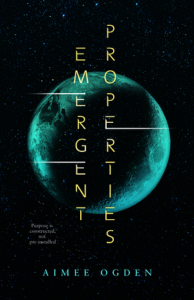 Emergent Properties, Aimee Ogden
Emergent Properties, Aimee Ogden
Received to review via Netgalley
I quite enjoyed Emergent Properties while I was reading it, but I don’t think it quite came together for me — I’m reviewing this a few days after finishing, and I confess, I’m not entirely sure what to say. I wouldn’t compare it too much to the Murderbot books, which have a very distinctive voice and attitude — this book has some similar themes, and even some similarities of voice, but is a little less… mature-feeling, I guess?
I did enjoy the setup of the mystery, and having to try and figure out what exactly is going on, without giving the game away. However, I kind of lost the thread of it between the body swaps and the random (-seeming) attacks on Scorn, and also the interlude in the black box bar.
There’s a lot of interesting stuff going on — the part in the black box bar actually intrigued me a lot since it imagined how AIs and others might interact, and how something akin to the internet (but older) might be. I think the Aura thing felt cribbed from Black Mirror, though (or at least, that’s where I know that whole social score thing from — even though I don’t myself watch Black Mirror!).
All in all, I had fun, it just didn’t quite come together for me. I’d read more by the author, and even more with this character or this world.
Rating: 3/5
Tags: Aimee Ogden, book reviews, books, SF/F
Posted June 5, 2023 by Nicky in Reviews / 4 Comments
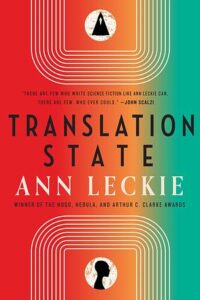 Translation State, Ann Leckie
Translation State, Ann Leckie
Received to review via Netgalley
I’ve been a big fan of Ann Leckie for a while: even though Ancillary Justice didn’t work for me immediately, it found a huge place in my heart anyway. So I was pretty excited to get a chance to read this early and review it, and dived in as soon as I could! Like Provenance, it’s in the same world as Ancillary Justice, but it focuses on another group of characters, including a Presger translator. It’s an opportunity to learn a bit more about the Presger, and perhaps about the Radchaii interactions with them, that I was really excited about.
There were certain elements of this story (the cannibalism) that really felt weird for me and icked me out a bit; I definitely wasn’t expecting them, so that’s something to be aware of before you pick it up if you’re a bit squeamish. There is a point behind it all, all the same, and of course Leckie takes another dive into the issues of gender and identity and personhood, from a different angle again from in the Breq books or in Provenance.
I think overall this isn’t my favourite of the bunch, though I appreciate it a lot, and the glimpse it gives of things everyone’s bound to be curious about (the Presger, but also other parts of non-Radchaii space, and some of the other races). I was excited by a couple of the appearances of characters from the other books, about which I shan’t say too much.
Well worth it, of course — and I’m sure it’ll grow on me, to be honest.
Rating: 4/5
Tags: Ann Leckie, book reviews, books, SF/F
Posted June 3, 2023 by Nicky in Reviews / 0 Comments
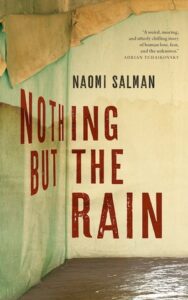 Nothing but the Rain, Naomi Salman
Nothing but the Rain, Naomi Salman
Received to review via Netgalley
If you like to know the whys and wherefores, Nothing but the Rain is not going to be for you. It explains nothing about its central premise, which is that all of a sudden, water (not just rain, but water coming out of the taps as well) induces amnesia in people in a certain town. A droplet of water might take away a few seconds of memory; a sudden inundation might wipe out a person’s entire memory and leave them empty of everything.
And we never find out why! Which I know will be deeply infuriating to some folks, so I mention it first here because it’s important to know. Instead, the story is more about how people might act in this situation, and how one particular person — the narrator — makes her way.
There were a few things other than the basic premise that I feel weren’t thought through. For example, at one point a character does something to the narrator that she should’ve been suspicious about — she has 24 hours of her memory removed, not weeks, so she should notice a particular thing is amiss. (I don’t want to say too much; when this gets posted on my blog [breathesbooks.com], I’ll happily elaborate in comments if anyone else who has read it wants me to point to the thing that bugged me.)
It’s overall an interesting idea and execution, and I don’t actually mind that we don’t know why the situation is happening, but I do mind when things like that don’t connect up. The ending has a nice sting in the tail.
Rating: 3/5
Tags: book reviews, books, Naomi Salman, SF/F
Posted June 2, 2023 by Nicky in Reviews / 0 Comments
 Crimes of Cymru, ed. Martin Edwards
Crimes of Cymru, ed. Martin Edwards
These aren’t strictly all one thing: some are stories written by Welsh writers (and not necessarily set in Wales), while others are by non-Welsh writers (but set in Wales). As a result, it’s a fairly mixed bag, but still a fun collection.
I was pleased by the inclusion of a story by Rhys Davies, whose work I enjoyed when I was doing a Welsh fiction in English course — I do wonder if it might’ve been possible to find more works by Welsh authors, but on the other hand, it did seem that some of those included were already pretty obscure.
As always, I enjoyed this more than I expected to: somewhere in my head I have the idea that I’m not that into short story collections, at least not themed ones that can contain works of varying quality… but the British Library Crime Classic ones have been pretty universally entertaining.
Rating: 4/5
Tags: book reviews, books, British Library Crime Classics, crime, mystery
Posted May 29, 2023 by Nicky in Reviews / 1 Comment
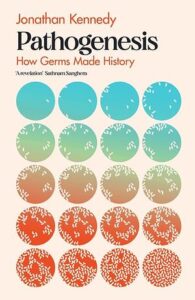 Pathogenesis, Jonathan Kennedy
Pathogenesis, Jonathan Kennedy
Pathogenesis was less absorbing for me than I’d hoped; I love non-fiction about diseases, even though I’m already studying for my MSc in the subject and thus most of it is not new to me. Still, often there are titbits I didn’t know, and that seemed like it was going to prove true here too when I read the introduction: did you know that viral genes are involved in the formation of the mammalian placenta?
But overall, the rest of it was much less scientific, less based on… well… pathogenesis, and much more about history. How diseases affected armies and governments, and how changes like capitalism (of which the author seems to be a huge fan) changed the approach to public health. Which is to say, created a demand for it, since there was no such thing under feudalism.
For someone who is interested in the history of infectious diseases in relation to humanity, this is probably still fascinating. For me, it was just a bit to starboard of my real interests, and I found it far too simplistic in discussing how diseases work. (Plus, there was definitely a lot more room to consider the impacts of the current pandemic and what it means for the future. Consider the impact on the treatment of tuberculosis, for example — deeply negative.)
It was alright, but not what I wanted, ultimately.
Rating: 3/5
Tags: book reviews, books, history, Jonathan Kennedy, non-fiction, science
Posted May 27, 2023 by Nicky in Reviews / 0 Comments
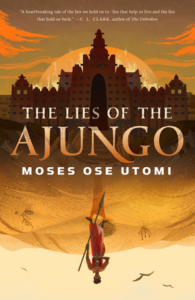 The Lies of the Ajungo, Moses Ose Utomi
The Lies of the Ajungo, Moses Ose Utomi
Received to review via Netgalley
The Lies of the Ajungo is very short, shorter than I’d expected, and follows the journey of one boy from the City of Lies. Slowly, he begins to meet people from other cities, begins to learn their stories, and perhaps to have the tools to unravel the problems they all turn out to share. I didn’t find the eventual secret too surprising, but I did enjoy the journey, the accumulation of evidence that finally made the whys and wherefores clear.
I’m surprised to read that this is actually going to have a sequel/companion, because it felt very self-contained. I can see where you could fill in the gaps in the world, but at the same time, I’m not sure why you’d want to. It feels like a fully-formed thing of its own, and almost with a moral to it, like a story plucked from the middle of a set of stories from One Thousand and One Nights (or The Decameron, or the Canterbury Tales, if they hadn’t been such very white European stories).
I enjoyed the reading experience well enough without getting deeply absorbed or very involved with it. I’d be curious to read more, but I’m not in a hurry for it and if I don’t read more, I’ll be alright with that.
Rating: 3/5
Tags: book reviews, books, Moses Ose Utomi, SF/F
Posted May 23, 2023 by Nicky in Reviews / 1 Comment
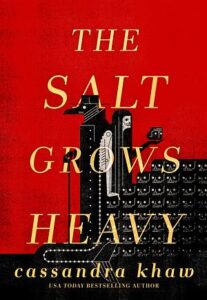 The Salt Grows Heavy, Cassandra Khaw
The Salt Grows Heavy, Cassandra Khaw
Received to review via Netgalley
I didn’t expect to come away from this book thinking about how oddly tender and romantic it was! Which is not to say it would appeal to someone who is looking for those things, because there’s a lot of gore and darkness as well, and this is definitely more dark fantasy/horror than romance. It’s just that out of that dark story, the friendship that grows up between the narrator and the plague doctor really shines.
I think the juxtaposition of that against the gore and darkness actually makes it feel a lot stronger, where it otherwise might feel unsatisfactory for want of detail.
Khaw doesn’t give you a lot to work with here in terms of setup or worldbuilding: each piece of information you get is fed to you a sliver at a time, with many unanswered questions left over at the end. You don’t know every step that brought the characters to where they are, nor exactly where they will go from the end — these things are just sketched in, leaving the horror and the relationship between the two main characters in strong relief.
It would not, on the surface, be my kind of book, but the plague doctor won me over.
Rating: 4/5
Tags: book reviews, books, Cassandra Khaw, horror
Posted May 20, 2023 by Nicky in Reviews / 0 Comments
 Cibola Burn, James S.A. Corey
Cibola Burn, James S.A. Corey
[This review never got posted back when I read the book, and has been waiting in buffer since then! Don’t worry, I didn’t read the later books before this one…]
This one’s complicated. I read this enormously fast, and only once bogged down and got stuck on not quite wanting to pick it up again. Getting bogged down and getting stuck might sound bad, but it mostly happens when I get anxious for the characters, which was happening in spades, and getting unstuck depends on the pace — if it lingers too long, I might never get through it.
But… I found aspects of the ending very similar to the first book (with elements of the third), and it felt like for all the high drama and death and flashing lights, it didn’t get us anywhere. Other people have mentioned that it is important later, but it doesn’t feel like it at the end of the book: it feels like we get right back to the status quo in many ways, especially for the crew of the Rocinante.
A lot of the characters are sucky people, as well. Murtry, for instance, just doesn’t feel real because he is a complete cartoon corporate villain, and I wouldn’t have been terribly surprised for him to do some insane maniacal laughter. It makes no sense that nobody seemed to see him for what he was before Ilus.
Also, not enough of Naomi doing stuff. And Amos didn’t get to shoot enough people.
So yeah, a bit frustrating and not my favourite, despite being a very grippy read.
Rating: 3/5
Tags: book reviews, books, James S.A. Corey, SF/F
 And Put Away Childish Things, Adrian Tchaikovsky
And Put Away Childish Things, Adrian Tchaikovsky








